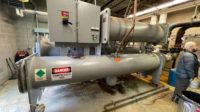It seems simple enough doesn’t it? I need a new burner or controls for my boiler, furnace, or oven, and you have these to sell. You give me a price, do the work, and then we’re all happy, right?
Wrong! Unless we do some very careful planning and communicate very carefully, we could be in for trouble. All too often, our firm is hired by many of our clients in the role of arbitrator, mediator, and neutral third-party expert on projects that have gone wrong. The end result of these projects gone wrong can range from damaged equipment that is out of service for months, to long and ugly lawsuits. What’s even worse is the wasted money and time on the part of the equipment owner.
Project Scoping and Responsibilities
We encounter very few OEMs that make their own burners and control systems. Therefore, calling them back in often brings no peace of mind for a correct and functioning project. Retrofits are a different animal. You are asking someone to try to fix, in some cases, years of neglect and a history of changes made to a piece of equipment.For example, in the case of a boiler that is getting a new low NOx burner, there are several issues that can make for disappointment. Sometimes, conditions inside the boiler itself may have changed over the years, such as the spacing of tubes between passes that can make for leaked CO rich flue gas to the flue. This is not the fault of the burner, but it would most likely be discovered in the burner commissioning process. Whose fault is this? How do you as a customer feel when you are told the burner does not meet performance expectations but it is not the burner vendor’s fault?
What about a furnace or oven where the contractor starts to tear into that “snake pit” of a junction box and finds out things are not as they seemed? What happens now? Is it fair for the contractor to eat 25 years of sins and problems?
No retrofit project should commence without a formal meeting to discuss all of the problems that could crop up and all of the possible contingencies. Better that everyone knows that even under the best of circumstances sometimes these projects do not go well, rather than to try and deal with this later.
Safety Devices and Close-Outs
It should be understood that changing anything regarding the piping of a fuel train should trigger certain automatic events, regardless of what anyone thought the scope was. For example, any time a fuel train is opened up for any reason, the tightness of all automatic valves in a system should be checked immediately prior to putting the device back into service. They should again be checked within two weeks, and then again after three months before the normal annual schedule is continued. Opening up any fuel train creates the risk of passing contamination down into valve sealing areas.The other issue that becomes very important is properly closing out a retrofit. Every retrofit project should include a contractor verifying the functionality of all safety devices in every possible failure mode, and the verification of the correct setpoints and calibration of all control and safety devices, whether they were part of the project or not. Complete combustion fuel/air ration setting and verification should follow. Of course, this kind of attention to detail should be built into the original pricing and project scope.
It is also important to understand that testing and calibration can mean the discovery of problems. You cannot ask a contractor to be responsible for the cost of replacing failed components, deriving switch setpoints that were never correct, and/or the replacement of devices or the discovery of issues that may have been a problem for years. Here is where you need to have confidence in whoever you are using and make sure that you have a source for a second opinion.
It also makes sense to ensure that whoever you are using is able to provide you with an analysis of how your current equipment and safety systems match up with the current versions of the latest applicable safety codes. This would be NFPA 85 for boilers and NFPA 86 for ovens and furnaces (available at www.nfpa.org). It may be illegal to do a partial retrofit in some states and not make a piece of equipment totally compliant with the latest code version.
Please remember that any time a piece of equipment’s flame safety or control logic is modified, you should involve your insurance provider. This is usually your property and casualty (fire) insurance company for ovens and furnaces, and/or fuel train or burner changes on boilers. In most cases, they will want to review what you are doing, including approving drawings. You need to build in approximately one month into your project schedule for these reviews.
The Start Sets The Tone
Retrofitting fuel trains, controls, and burners is not a simple or straightforward process. When someone says they are upgrading controls, remember there are two systems they could be referring to. Every piece of fuel-fired equipment has two control systems, the CCS (sometimes called the combustion control system) and the BMS (burner management system or safety controls). These are usually two separate and distinct systems. Make sure everyone’s talking about the same thing.It is important to make sure that everyone enters into these projects with wide-open eyes. They need to communicate often, budget properly, and have the proper insurance folks involved for reviews, all before implementing a rigorous and well-defined close-out process. It does not have to get ugly or be difficult, but it can sure get that way in a hurry if you are not prepared.ES





